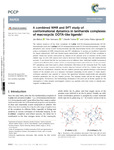Mostrar o rexistro simple do ítem
A combined NMR and DFT study of conformational dynamics in lanthanide complexes of macrocyclic DOTA-like ligands
| dc.contributor.author | Blahut, Jan | |
| dc.contributor.author | Hermann, Petr | |
| dc.contributor.author | Tošner, Zdeněk | |
| dc.contributor.author | Platas-Iglesias, Carlos | |
| dc.date.accessioned | 2019-11-06T09:11:38Z | |
| dc.date.available | 2019-11-06T09:11:38Z | |
| dc.date.issued | 2017-09-06 | |
| dc.identifier.citation | J. Blahut, P. Hermann, Z. Tošner and C. Platas-Iglesias, A combined NMR and DFT study of conformational dynamics in lanthanide complexes of macrocyclic DOTA-like ligands, Phys. Chem. Chem. Phys., 2017, 19, 26662–26671. | es_ES |
| dc.identifier.issn | 1463-9076 | |
| dc.identifier.issn | 1463-9084 | |
| dc.identifier.uri | http://hdl.handle.net/2183/24248 | |
| dc.description.abstract | [Abstract] The solution dynamics of the Eu(III) complexes of H4dota (1,4,7,10-tetraazacyclododecane-1,4,7,10-tetracarboxylic acid) and H5do3ap (1,4,7,10-tetraazacyclododecane-4,7,10-tris(carboxymethyl)-1-methylphosphonic acid, bound in both monoprotonated and fully deprotonated forms) were investigated by using a combination of NMR measurements and DFT calculations. In solution, an equilibrium between the square antiprismatic (SAP) and twisted-square antiprismatic isomers (TSAP) of these complexes is present. These two isomers interconvert by rotation of the pendant arms or inversion of the cyclen chelate rings. 1D EXSY NMR spectra were used to determine these exchange rates with unprecedented accuracy. It was found that the two processes occur at different rates. Additional variable-temperature measurements allowed determination of the corresponding activation parameters for the two processes. DFT calculations were then used to obtain mechanistic information at the molecular level. The results show that the cyclen inversion pathway involves stepwise inversion of the four chelate rings formed upon metal ion coordination. However, the arm rotation process may operate through a synchronous rotation of the pendant arms or a stepwise mechanism depending on the system. A mixed cluster-continuum approach was required to improve the agreement between experimental and calculated activation parameters for the arm rotation process. The obtained results will aid the design of MRI contrast agents. Furthermore, the methodology developed in this work can be further applied for the investigation of other dynamic paramagnetic systems, e.g. peptides with Ln(III) probes or natively paramagnetic metalloproteins. | es_ES |
| dc.description.sponsorship | Czech Science Foundation; 16-03156S | es_ES |
| dc.description.sponsorship | Charles University; 1076016 | es_ES |
| dc.description.sponsorship | Czech Republic. Ministry of Education; LTC 170607 | es_ES |
| dc.description.sponsorship | Ministerio de Economía y Competitividad; CTQ2013-43243-P | es_ES |
| dc.language.iso | eng | es_ES |
| dc.publisher | Royal Society of Chemistry | es_ES |
| dc.relation.uri | https://doi.org/10.1039/c7cp05296k | es_ES |
| dc.rights | Atribución-NoComercial 3.0 España | es_ES |
| dc.rights.uri | http://creativecommons.org/licenses/by-nc/3.0/es/ | * |
| dc.subject | Lanthanides | es_ES |
| dc.subject | Gadolinium | es_ES |
| dc.subject | NMR | es_ES |
| dc.subject | Contrast agents | es_ES |
| dc.subject | DFT | es_ES |
| dc.title | A combined NMR and DFT study of conformational dynamics in lanthanide complexes of macrocyclic DOTA-like ligands | es_ES |
| dc.type | info:eu-repo/semantics/article | es_ES |
| dc.rights.access | info:eu-repo/semantics/openAccess | es_ES |
| UDC.journalTitle | Physical Chemistry Chemical Physics | es_ES |
| UDC.volume | 19 | es_ES |
| UDC.issue | 39 | es_ES |
| UDC.startPage | 26662 | es_ES |
| UDC.endPage | 26671 | es_ES |
Ficheiros no ítem
Este ítem aparece na(s) seguinte(s) colección(s)
-
GI-REACT! - Artigos [113]






